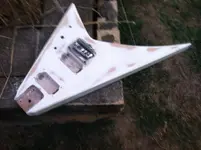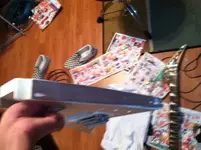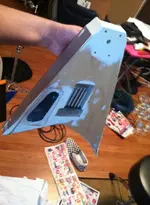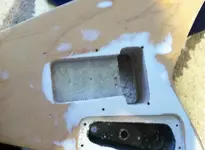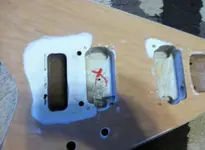Soory for not replying as promised, I got completed side tracked with work stuff...
Back onto finishing.
That Shellac should be ok as a sealer and barrier coat as long as it is shellac based. Shellac is a great way of insuring that one finish will take onto another of a different type as it will stick to just about anything. You don't need a lot. do three or four mist coats and cut back between with your 400 grit very lightly (known as denibbing)..
What you will have then is a sound surface on which to start bodying up the colour and the clear top coat. You can pretty much choose whatever type of lacquer you like but stick to the same type for colour and top coat. I would even recommend sticking to the same brand. Let me know what type of lacquer you opt for and I'll give you some type specific tips...
The golden rule with finishing that I always chant as a mantra here is "test on scrap". I still do it after over 35 years... Get some scrap ply and sand it back and put the shellac on it so it's at the same stage as the body. Then test every step before you hit the guitar body..
Always read and follow the manufacturers instructions on gassing off times and NEVER put too much on. I would start with a primer coat. If you are going for black then use the grey primer. Mist a coat on first then put on a another coat until you have a solid colour. Let it dry and lightly denib with 400. If you run through in any spots just dodge them in and denib. I cant emphasize enough, less is more. Don't put too much on in a single coat.
From now on everything you do will be visible so take time and care. I'm guessing you will be using rattle cans so practice your technique first. A few tips,
Never start the can going when it's stationary, always keep the can moving. Start away from the body and keep the can the same distance from the work (8 -12 inches is best). Press the nozzle once you arm is moving not before. kEEP THE CAN LEVEL, MOVE THE ARM NOT THE WRIST..KEEP THE SAME SPEED GOING, don't speed up slow down. Take your finger off the nozzle once you have cleared the body. Shake the can vigorously for ten seconds between every few passes. Keep a cloth handy to wipe the nozzle every few passes as it will help stop spitting and keep the nozzle clear.. Never go over an area that you have just done. Leave it until it's dry and hit it again. If you can still see the primer colour don't worry, three or four light coats are better than two heavy coats. If you load too much on in one go you will be storing up problems as the solvent needs to gas off. Once you get a feel for it you should be able to overlap each pass by a half inch or so, no more. The moment the can starts to spit either change it or let is stand for a good ten minutes and shake it as if you are starting a fresh. From my experience one in about five of those cans are no good so don't worry of you have to bin or return it.. They are what they are and to get a professional finish you have to use them well and carefully. There is a knack to it, you'll get it. Practice on scrap.
If you do it properly you will need maybe 4 coats to build up the colour, you can denib between coats depending on how clean you work and how much dust you have around. If you cant get a clean room or area then put some buckets of water around the place as that will help pull dust out of the air but keep the place ventilated. Avoid letting insects anywhere near where you are working. They love lacquer. If you want to do it out doors pick a dry, overcast day if possible or work in a well shaded area and watch out for insects... You have been warned..

Once you have the colour down hit it with 400 or even better 600 grit lightly all over. If you run through dodge it in with a light coat of colour.
Wipe all the dust off and prepare for top coats. These have to be spotless or you will see any little specks in the final finish. Load up a dozen really fine thin coats of clear. You can denib every few coats and make sure you wipe clean each time. No dust at all needed here.
For the final few coats you will want to load up a bit heavier but not to heavy. By this time you should have a good feel for the amount you can lay up with out it running or sagging.. When you have those last few coats done and everything looks good. Go hang it up some where clean, dry and well ventilated and forget about it for a few weeks..
You will benifit from thinking through the work area before hand. Have everything to hand and be patient. You will need to find a way to secure the guitar so you can move it while spraying as you will want to be able to hit the whole thing when you do the last top coats. The primer and colour you can work one face then let it cure and work the other face. I always screw a hook stick to the neck pocket and have a dowel or stick screwed in where the end pin goes. That way I can handle it easily without ever touching the finish. I also use a lazy susan table that comes in handy for turning if I dont have a way of hanging or want to lay up from above.
Good luck... and any questions or stuff I've missed just shout..
Did I mention...
TEST ON SCRAP.

